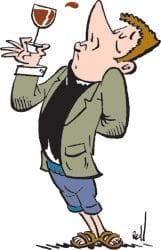
Need a wine mystery solved? Ask "Vino Joe" -- the alter-ego and unofficial mascot of the Wine365 Staff.
All answers are thoroughly researched and vetted by wine industry experts -- such as the people you can learn about here.
You see "legs," but do you know how to use them?

What does it mean when a wine has legs? Is it true that a wine can have “great legs”?
— Maggie M.

Hi Maggie, the “legs” refer to droplets or streaks of liquid falling down the inside of the glass after swirling. It is a longtime myth that the quality of a wine can be determined by these “legs” (or “teardrops”), however, that myth has been busted. The appearance, size, and thickness (or viscosity) of a wine’s legs MIGHT be related to the amount of alcohol in a wine, but that’s about it. These “legs” occur as a result of contrasting evaporation points and surface tension between wine and water, and is affected by temperature. Sound complex? It is — so complex, in fact, that it was studied by NASA! Look for an in-depth article on wine legs coming up soon on Wine365.com. Until then, have fun looking at them, but don’t let them influence your opinion — there’s much more to a wine than great legs.
Have a wine question for Vino Joe? Ask it below!




